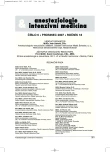Emergency Preservation and Resuscitation: A new chance for traumatic cardiac arrest victims
Authors:
T. Drábek
Authors‘ workplace:
Pennsylvania, USA
; Department of Anesthesiology, Safar Center for Resuscitation Research, University of Pittsburgh, Pittsburgh
Published in:
Anest. intenziv. Med., 18, 2007, č. 6, s. 351-356
Category:
Intensive Medicine
Overview
The outcomes from resuscitation of cardiac arrest victims remain suboptimal. Conventional resuscitation approach to trauma-related exsanguination cardiac arrest carries especially dismal prognosis. A majority of the patients die at the scene. However, some of the injuries could be surgically repairable. Emergency Preservation and Resuscitation (EPR) is a novel resuscitation method using large-volume ice-cold aortic flush to induce hypothermia, a key mechanism decreasing metabolic demands.This buys time for the transport, damage-control surgery and delayed resuscitation using cardiopulmonary bypass.
The depth of hypothermia correlates well with the duration of the arrest that still allows favourable neurologic outcome. In a large animal model we were able to achieve good outcome after 120 min of total cardiac arrest at 10 °C. This period provides an ample time to transport the victim from even the most remote areas to the operating theatre. Rapid onset and deeper levels of hypothermia are associated with better outcomes. The role of pharmacological adjuncts to hypothermia seems to be limited. Blood components, haemoglobin and energetic substrates may be beneficial during the induction of hypothermia. Oxygen radical scavengers can ameliorate secondary ischaemia-reperfusion injury. The potential role of EPR in normovolaemic cardiac arrest remains to be elucidated. Over the last 20 years since the original concept was formulated, EPR has progressed from experimental studies to a multicentric clinical trial, showing EPR as one of the few promising strategies for traumatic cardiac arrest victims.
Keywords:
hypothermia – cardiac arrest – suspended animation – cerebral ischaemia – resuscitation – extracorporeal circulation
Labels
Anaesthesiology, Resuscitation and Inten Intensive Care MedicineArticle was published in
Anaesthesiology and Intensive Care Medicine

2007 Issue 6
Most read in this issue
- Neuromodulation in chronic pain management
- Cardiocerebral resuscitation: For laymen without ventilation?
- Advances in general anaesthesia
- Lipid resuscitation: Progress in the pharmacology of local anaesthetics – a view from the perspective of the year 2007
